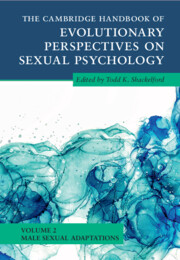Book contents
- The Cambridge Handbook of Evolutionary Perspectives on Sexual Psychology
- The Cambridge Handbook of Evolutionary Perspectives on Sexual Psychology
- Copyright page
- Contents
- Contributors
- Preface
- Part I Precopulatory Adaptations
- Part II Copulatory Adaptations
- Part III Postcopulatory Adaptations
- 14 Postejaculatory Adaptations to Self-Semen Displacement
- 15 Male Mate Retention
- 16 Shifts in Partner Attractiveness
- 17 Emotional Commitment in Men
- 18 Sexual Jealousy in Males
- 19 Men’s Attachment-Related Needs in the Sexual Arena
- 20 Paternal Care
- 21 Paternal Filicide
- Index
- References
21 - Paternal Filicide
from Part III - Postcopulatory Adaptations
Published online by Cambridge University Press: 30 June 2022
- The Cambridge Handbook of Evolutionary Perspectives on Sexual Psychology
- The Cambridge Handbook of Evolutionary Perspectives on Sexual Psychology
- Copyright page
- Contents
- Contributors
- Preface
- Part I Precopulatory Adaptations
- Part II Copulatory Adaptations
- Part III Postcopulatory Adaptations
- 14 Postejaculatory Adaptations to Self-Semen Displacement
- 15 Male Mate Retention
- 16 Shifts in Partner Attractiveness
- 17 Emotional Commitment in Men
- 18 Sexual Jealousy in Males
- 19 Men’s Attachment-Related Needs in the Sexual Arena
- 20 Paternal Care
- 21 Paternal Filicide
- Index
- References
Summary
Evolutionary perspectives offer a comprehensive theoretical approach to parental investment, as they include not only explanations for why an individual makes such investment, but also for why an individual might withhold such investment. These explanations lay the foundation for deriving predictions concerning when an individual will be more or less likely to withhold investment. This chapter introduces evolutionary psychological perspectives on paternal filicide (i.e., child homicide perpetrated by a man in the context of paternal care). These perspectives suggest that reproductive conflicts between men and the children in their care may activate mechanisms that evolved to regulate paternal investment. These mechanisms may increase the risk of a lethal lowering of investment. Further, these perspectives suggest that reproductive conflicts between men and their current or former partner may activate mechanisms that increase the risk of both filicide and familicide (i.e., the killing of a current or former partner in addition to children). Paternal filicide is then, despite being rare in current societies, no less a result of men’s evolved psychology. This chapter presents the theoretical foundation for disaggregating paternal filicide perpetrators who are genetic fathers from those who are stepfathers of their victims, and paternal filicide perpetrators suffering from nonadaptive psychopathology (such as psychosis or suicidal ideation) from those not suffering from psychopathology. The chapter will further present the theoretical foundation for predicting a distinct pattern of characteristic traits for each of these subcategories, along with a selection of the empirical support for the predicted pattern documented cross-culturally. Although paternal filicide perpetration is reduced to historic lows in several societies, there are still certain groups of men in these societies that are more vulnerable to perpetrating paternal filicide. The chapter will identify these groups of men and suggest why their vulnerability persists, focusing on Scandinavian countries.
Keywords
- Type
- Chapter
- Information
- Publisher: Cambridge University PressPrint publication year: 2022
References
- 3
- Cited by



